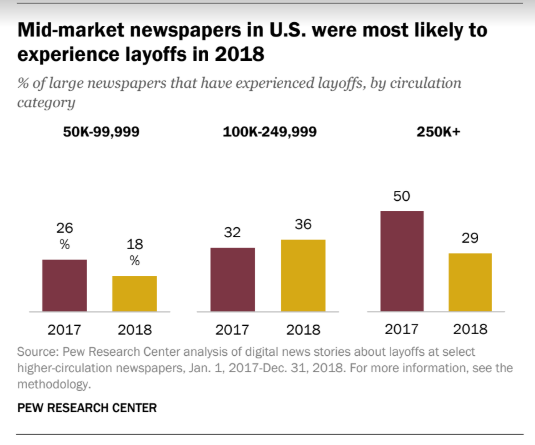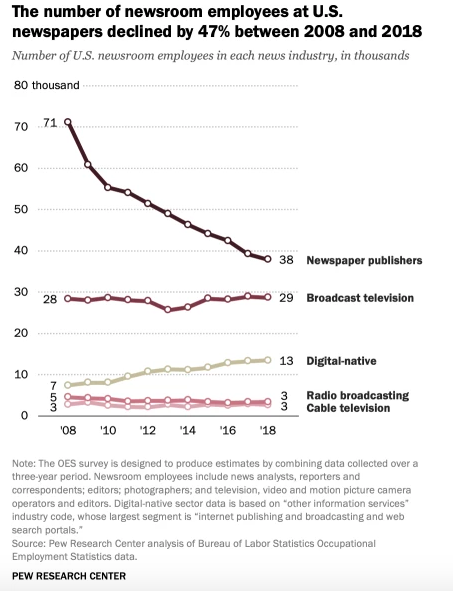It’s only August, but 2019 has already been a rough year because of layoffs in the news industry. In more Do-you-have-a-plan-B?-news, a new study from Pew Research shows that in 2018, slightly fewer papers had layoffs than in the year before, but a higher number had multiple rounds.
Pew’s report, which published Thursday, used “publicly reported instances of layoffs.” Researchers looked at 97 newspapers with Sunday circulation of 50,000 or more.
Some of the findings:
- Overall layoffs dropped slightly: In 2017, 32% of newspapers went through layoffs. In 2018, that number was 27%.
- But the number of papers that had multiple rounds nearly doubled: In 2017, 17% of newspapers had multiple rounds of layoffs. In 2018, that number was 31%.
- Also, when papers had layoffs, they laid off more people: In 2017, 42% laid off more than 10 people. In 2018, 62% laid off more than 10 people.
- Mid-market newspapers, the report found, with Sunday circulation between 100,000 and 249,999, had more layoffs than smaller and bigger papers.

Image via Pew Research Center
The report also found that layoffs at large digital news outlets continued from 2017 to 2018, but the rate slowed from 20% in 2017 to 14% in 2018.
In July, Pew reported that employment at U.S. newsrooms dropped 25% from 2008 to 2018. Newspapers were hit the hardest, with a loss of 47% of newspaper jobs in that time.

Image via Pew Research Center
In that same report, Pew found that broadcast jobs were stable from 2008 to 2018, but radio broadcasting jobs had dropped by 26%. And let’s not forget digital.
According to the July report: “Of the five industries analyzed, notable job growth occurred only in the digital-native news sector. Since 2008, the number of digital-native newsroom employees has increased by 82%, from about 7,400 workers to about 13,500 in 2018. This increase of about 6,100 total jobs, however, fell far short of offsetting the loss of about 33,000 newspaper newsroom jobs during the same period.”
Related: Grieve, but don’t give up (and other lessons from layoffs)
The report comes out two days after Poynter’s Tom Jones reported that the robustly-staffed Los Angeles Times was pretty far from its digital subscription goal.
At the beginning of the year, Poynter looked back at the past decade, with major shifts in technology, corporate ownership and the business of the news. We wondered: Did we just experience the hardest decade in journalism?
Since our crystal ball is broken, we can’t say for sure. But along with the newsroom employment data points, here are a few much smaller but still important data points to consider:
- Local Independent Online News Publishers (or LION) now has 265 members, up from 115 in 2015.
- The Institute for Nonprofit News now has more than 230 members (with some overlap with LION.)
- Local online newsrooms including the Texas Tribune and VTDigger are operating with healthy budgets and staffs.
- Projects such as ProPublica’s Local Reporting Network and Report for America are helping to shore up local reporting through grant-funded positions.
- In May, Nieman Lab reported that the Boston Globe was the first local paper to build more digital subscribers than print.
- The American Journalism Project has $42 million to invest in local news sites that need a boost in building the business side.
- And while Pulitzers don’t pay bills, they do recognize critical journalism. This year, despite shrinking, local newsrooms showed up.
Editor’s note: This story has been updated with INN’s current membership numbers.







